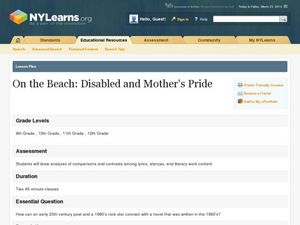Curated OER
Personalities of the Renaissance
Have the class interpret historical evidence presented in primary and secondary resources. They examine sources regarding architecture, art, exploration, government, literature, religion, and technology of the era. Then they use their...
Curated OER
Freak the Mighty: Chapter 18 Semantic Feature Analysis
Intelligent? Arrogant? Obnoxious? After completing Chapter 18 of Freak the Mighty, individuals fill out a semantic feature chart for characters in Rodman Philbrick's novel. Group members then use their charts to discuss relationships...
Virginia Department of Education
Numbers in a Name
What's in a name? Pupils create a data set from the number of letters in the names of classmates. Each group then takes the data and creates a visual representation, such as a histogram, circle graph, stem-and-leaf plot, etc.
Curated OER
Classic Columns
Sixth graders present a PowerPoint presentation on Greek columns. They realize that Greek culture is centered around religion. Students create a model of one of the columns. Also they find examples of Greek architecture in major Greek...
Curated OER
On the Beach: Disabled and Mother's Pride
What do an early 20th century poet and a 1980's rock star have in common with a novel from the 1960's? Using Wilfred Owen's poem "Disabled" and George Michael's song "Mother's Pride," learners answer questions about the lyrics and themes...
Curated OER
Fresh Water and land of Kiribati and Hawaii (Molokai)
Fourth graders examine the islands of Hawaii. Using this information, they organize it and create a map or graph that represents the data. As a class, they discuss how the watersheds on the islands are different and how people react to...
Curated OER
Migration Waves
Learners examine how migration waves impacted Native American history. They listen to a lecture and take notes, read and discuss handouts in small groups, and create a group table that illustrates the differences and similarities between...
Curated OER
Fairy Tales
Class groups examine fairy tales from a feminist and a Marxist perspective, identifying how these tales present gender roles and class/power systems. The groups then script and perform their own tale that uses one of these lenses.
Curated OER
Comparing Sea Horses and Knights
Students investigate sea horses and knights. For this marine biology lesson, students read the book How to Hide an Octopus and discuss the purpose of camoflage. Students research knights and sea horses and record their research on their...
Curated OER
Immigration Unit
Third graders develop an appreciate for the various cultures that are present in their local community. Through reading and research, they explain how various culture came to live in their area. At the conclusion of the unit, 3rd...
Curated OER
The Republic; Roman History, Democracy
Students explain the ways in which current American system of government both resembles and differs from the system of government in Rome form about 510 to 264 B.C.
Curated OER
"What is an American?"
Eleventh graders ponder about what it means to be an "American." They discuss the impact of an author's word choice and sentence structure on text. They identify some major themes and development of the Letters... Compose paragraphs and...
Curated OER
Muslim Arab/Spanish Connection
Ninth graders watch the video, 'El Cid.' They participate in teacher-led discussion about the beliefs, customs, goals, and heroes of both Spaniards and Moors. They create and present an artifact to the class showing the results of their...
Curated OER
Children in Hiding During the Holocaust
Young scholars examine the different ways in which children hid trying to escape the concentration camps. Using journal entries, they put themselves into the role of the children and imagine their feelings during the Holocaust. They...
Curated OER
Immigration in the United States
Students explore how recent immigration and migration patterns impact social and political issues. They apply affective learning techniques
Curated OER
Is Monopoly the Microsoft Board's Game?
Students first participate in an in-depth discussion about capitalism, monopolies, trusts, mergers, and the Sherman Antitrust Act. They work in groups to investigate past examples of corporations tried for antitrust act violations.
Curated OER
Power vs Truth
Students explore Italian politics and warfare of the High Renaissance. They explain the effects of the Protestant Reformation and the Counter Reformation.
Curated OER
Water-The Liquid Gold
Learners investigate the necessity of water for the survival of plants, animals, and people. They explore the affect that water has on human and natural environments through literature, field trips, and discussions.
Curated OER
All I Want for Christmas is a Nice, Clean Earth
Young scholars observe properties of items, determine time it takes for organic/inorganic items to decompose, identify differences/similarities between decomposition, identify practical uses in litter/garbage control, & establish...
Curated OER
Class President
Fourth graders develop vocabulary to aid in comprehension as they read the novel, Class President.
Curated OER
Dreaming of Gardens
Students demonstrate ways to be an environmental philanthropist. In this philanthropy lesson, students read The Gardener and Just a Dream and compare the two books. Students discuss ways the characters demonstrated environmental...
Curated OER
Technology-commected Folklife Lesson Plan: Fables
Learners discuss ways the stories were alike and different. The teacher demonstrate how to draw a Venn diagram using Microsoft Word. They label the two circles and enter the likenesses and differences on the diagram.
Curated OER
Predicting Temperature: An Internet/Excel Learning Experience
Third graders use the Internet (www.weather.com) to find the high temperature for our locale and the high temperature for another city around the world. They keep track of the temperature in these two locations for 10 days.
Alabama Learning Exchange
I Scream for Ice Cream!
Students perform an experiment. In this combinations lesson, students complete an experiment where they find out how many ice cream cone combinations they can make with 5 different flavors of ice cream and 4 types of cones. They design a...

























